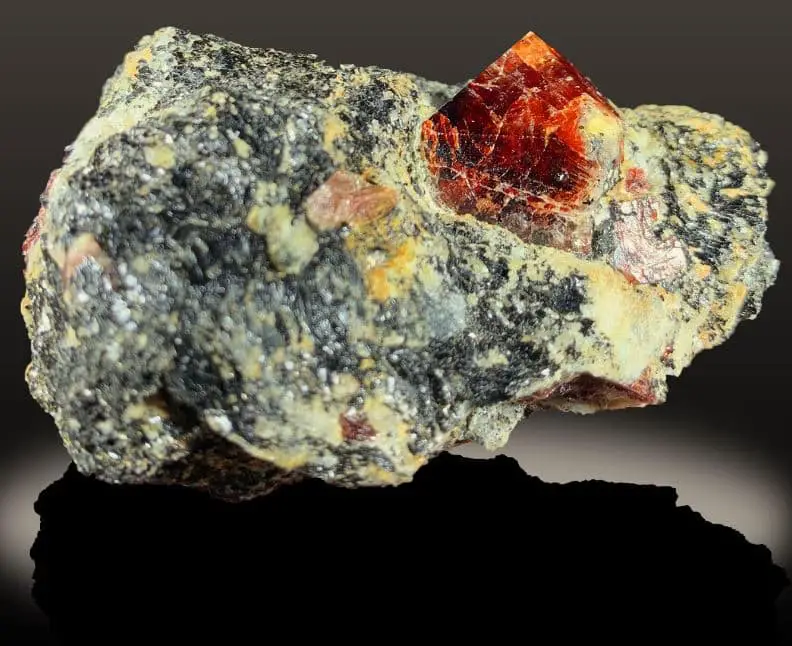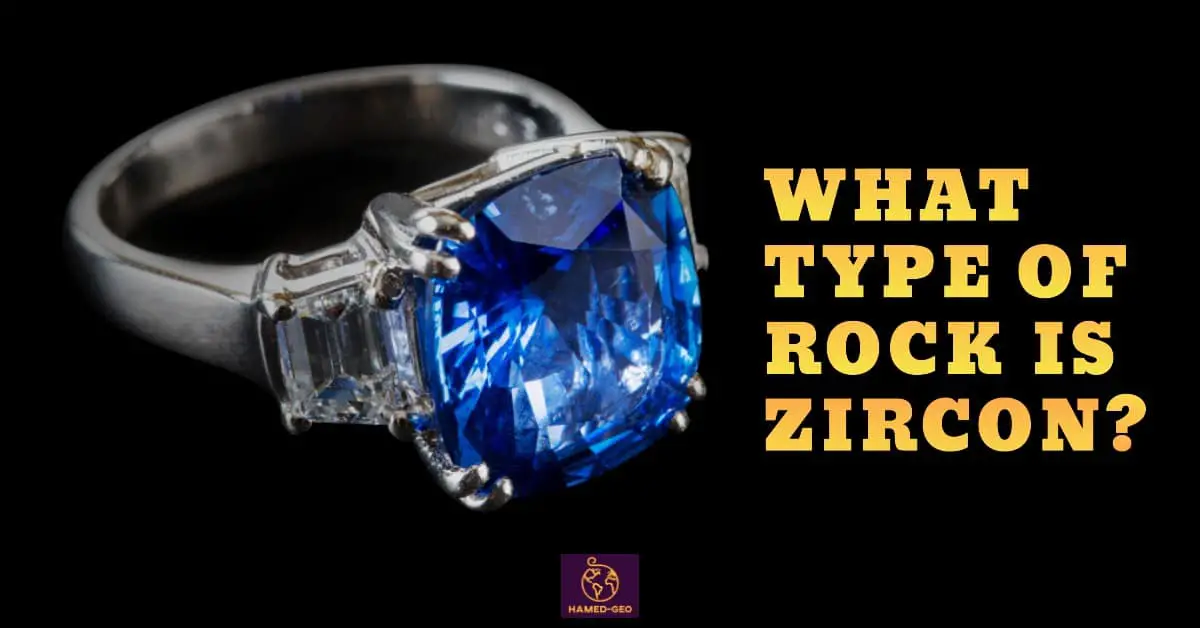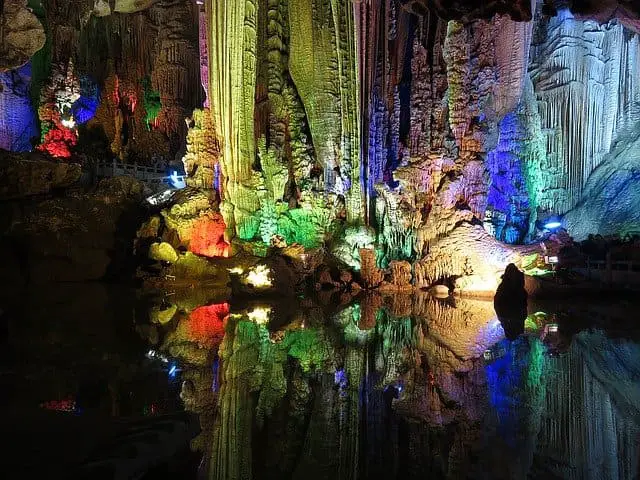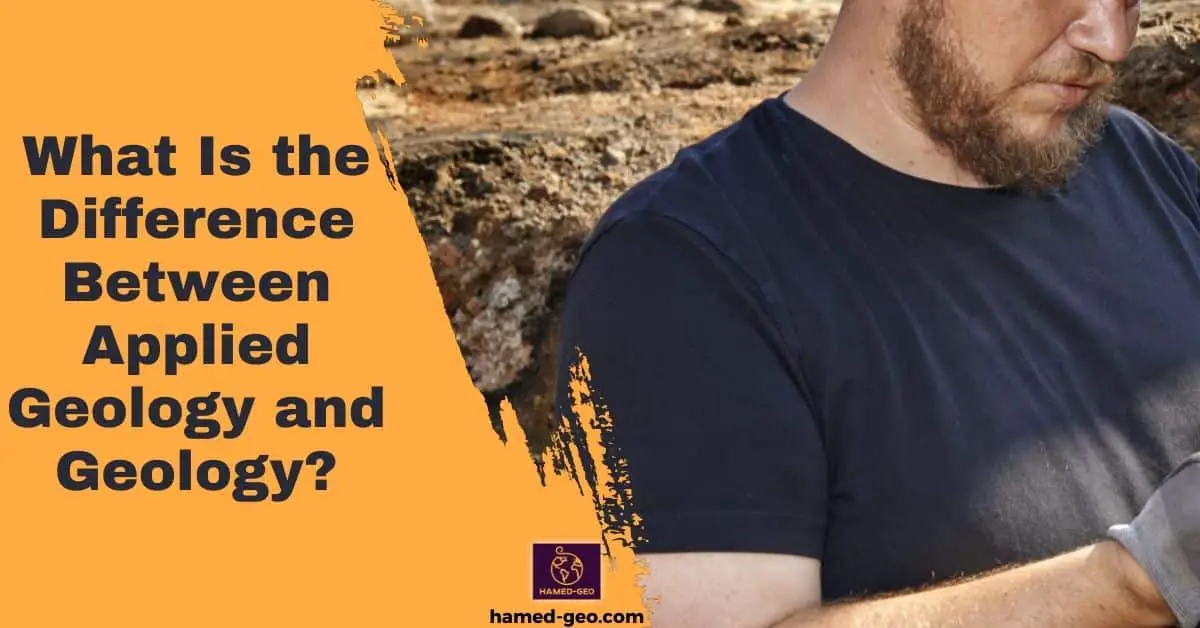Zircon is a precious stone that has become increasingly popular in recent years. Known for its stunning appearance and unique properties, zircon has become a sought-after gemstone. But what exactly is zircon, and how is it formed?
Zircon is a type of mineral that can be found in many different types of rocks. It is a silicate mineral that is made up of zirconium, silicon, and oxygen atoms. Zircon is typically brown or yellow in color, but it can also be found in shades of red, green, and blue. What makes zircon so unique is its ability to resist chemical erosion and damage from radiation. In fact, zircon is one of the oldest minerals on Earth, with some specimens dating back billions of years. It is often used in the jewelry industry as a substitute for diamond due to its similar appearance, but it is also used in various scientific and industrial applications due to its durability and resistance to heat and wear.
Overview of Zircon
Zircon, a unique mineral known for its brilliant luster and high refractive index, has a wide range of properties that make it valuable in various industries. Its properties include resistance to chemical attack, high melting point, and thermal shock resistance. In terms of location, zircon is found in a number of countries, including Australia, South Africa, and Brazil, among others.
Description of Zircon
Like a precious gem hidden in the depths of the earth, Zircon is a mineral that sparkles with unique beauty. Despite its name, zircon is not a man-made material but a naturally occurring mineral that is found in a variety of colors and sizes. Zircon is known for its remarkable brilliance and fire, making it a popular material for jewelry and decorative purposes.
Zircon has a chemical composition of zirconium silicate (ZrSiO4) and is commonly found in granitic and metamorphic rocks. It is also found in alluvial deposits, which are sedimentary rocks that have been eroded and transported by rivers and streams. Zircon can be identified by its high refractive index, which means that it bends light in a way that creates a dazzling display of colors and flashes of light.
In addition to its beauty, zircon also has several important industrial uses. It is used as a refractory material in furnaces and kilns, as well as in the manufacture of ceramics and glass. Zircon is also used as a gemstone substitute for diamond and is often used as a diamond simulant in jewelry. Despite its many uses, zircon is a relatively rare mineral, making it highly prized and sought after by collectors and jewelry enthusiasts alike.

Properties of Zircon
Zircon, a unique mineral, possesses a variety of properties that make it highly valuable. Among these characteristics are its color and hardness, which are influenced by the presence of impurities and defects in its crystal structure. In addition, the chemical composition of zircon determines its suitability for a wide range of industrial applications. Finally, the crystal structure of zircon gives it its distinctive shape and allows it to withstand extreme pressures and temperatures.
Color and Hardness
Moving on to the properties of Zircon, it is important to note that this mineral is truly unique in its appearance and durability. One of the most striking features of Zircon is its color. While it can come in a range of colors such as brown, yellow, and green, it is most commonly known for its stunning shade of blue. This vibrant color is unlike any other gemstone, making it a highly sought-after choice for jewelry makers and collectors alike.
In addition to its eye-catching color, Zircon is also known for its hardness. With a rating of 7.5 on the Mohs scale, it is one of the hardest minerals found in nature. This means that it is incredibly durable and resistant to scratches and abrasions. It is for this reason that Zircon is often used in industrial settings, such as in the production of ceramic and refractory materials.
Overall, the unique combination of Zircon’s vivid blue color and impressive hardness makes it an exceptional gemstone that is highly prized by many. It is truly a one-of-a-kind mineral that is sure to leave a lasting impression on anyone who sees it.
Chemical Composition
As fascinating as the types of rocks zircon can form may be, it is equally intriguing to explore the chemical composition of this remarkable mineral. Zircon is a silicate mineral containing zirconium, silicon, and oxygen, with small amounts of other elements such as thorium and uranium.
The chemical formula for zircon is ZrSiO4, with the zirconium atom located at the center of a tetrahedral structure. This results in a strong and durable crystal structure that makes zircon an ideal gemstone for jewelry. The presence of trace elements such as uranium and thorium can also affect the color of zircon, ranging from colorless to yellow, brown, and even green.
In addition to its aesthetic value, zircon’s unique chemical composition makes it useful in various industrial applications. It is used in the production of ceramics, refractory materials, and even nuclear fuel rods. Its high melting point and resistance to chemical attack make it an excellent material for high-temperature applications. The chemical composition of zircon truly makes it a valuable mineral with numerous practical uses.
Crystal Structure
Crystal Structure: A Glittering Marvel of Nature
As we delve deeper into the world of zircon, we come across its remarkable crystal structure. Unlike many other minerals that form amorphous lumps or granules, zircon forms beautiful, glittering crystals that can be admired for their complex and intricate shapes. These crystals are found in a variety of hues, ranging from colorless to yellow, red, and brown. But it is their stunning crystal structure that truly sets them apart.
Zircon’s crystal structure is characterized by its tetragonal symmetry, meaning that it has four-sided prisms with a square base. This structure is formed by the arrangement of its atoms and molecules, which are tightly packed together in a specific pattern. This results in a highly ordered and organized crystal lattice, which gives zircon its unique properties.
One of the most remarkable aspects of zircon’s crystal structure is its ability to withstand high temperatures and pressure. This makes it an ideal mineral for use in high-temperature applications, such as in the aviation and aerospace industries. Additionally, zircon’s crystal lattice structure makes it highly resistant to radiation, which makes it a valuable material for use in nuclear reactors. Overall, zircon’s crystal structure is a marvel of nature that continues to fascinate scientists and mineral enthusiasts alike.
Location of Zircon
Transitioning from the properties of Zircon, it’s time to delve deeper into the location of this precious gemstone. Zircon can be found in many parts of the world, making it a highly sought-after mineral. Australia is one of the top producers of zircon, with its largest mine located in the western part of the country. The country’s production accounts for almost half of the world’s total zircon output.
Another country that produces a significant amount of zircon is South Africa. In fact, the country is home to one of the world’s largest zircon mines, the Namakwa Sands mine. The mine is located in the Western Cape Province and produces around 25% of the world’s zircon. Additionally, South Africa also produces other minerals such as diamond, platinum, and gold.
Other notable locations where zircon can be found include Brazil, China, India, and Mozambique. These countries have their own unique geological features, making them ideal places for zircon to form. In Brazil, for example, zircon can be found in the coastal regions of the country, where it’s typically associated with other minerals such as tourmaline and topaz.
Types of Rocks Zircon Forms In
Zircon is a mineral that is known to form in various types of rocks, including igneous rocks, sedimentary rocks, and metamorphic rocks. Igneous rocks are formed from the solidification of magma or lava, while sedimentary rocks are formed from the accumulation of sediment and metamorphic rocks are formed from the alteration of pre-existing rocks due to heat and pressure. Each of these types of rocks provides a unique environment for zircon to form, resulting in distinct characteristics and properties.
Igneous Rocks
Moving on from the overview of Zircon, it is interesting to note the different types of rocks in which this mineral forms. Zircon is most commonly found in igneous rocks, which are formed from the solidification of molten magma or lava. Igneous rocks can be further divided into two categories: intrusive and extrusive.
Intrusive igneous rocks, also known as plutonic rocks, form when magma cools slowly beneath the Earth’s surface. The slow cooling process allows for large mineral crystals to form, including zircon. These rocks are often coarse-grained and have a visible crystalline texture. Common examples of intrusive igneous rocks include granite and gabbro.
On the other hand, extrusive igneous rocks, also known as volcanic rocks, form when lava cools quickly on the Earth’s surface. This rapid cooling process does not allow for large mineral crystals to form, resulting in a fine-grained texture. However, zircon can still be found in some extrusive igneous rocks, particularly those that have undergone a secondary process of crystallization. Examples of extrusive igneous rocks include basalt and pumice.
Sedimentary Rocks
Sedimentary rocks may not be the first type of rock that comes to mind when you think of zircon, but this mineral actually plays an important role in their formation. Zircon can be found in a variety of sedimentary rocks, including sandstone, shale, and conglomerate. These rocks are formed from the accumulation, compaction, and cementation of sedimentary material, such as sand, clay, and gravel.
Zircon is often used to date sedimentary rocks because it contains radioactive isotopes that decay over time at a known rate. By measuring the amount of decay, scientists can determine the age of the rock in which the zircon is found. This is particularly useful for dating ancient sedimentary rocks that may contain fossils or other important geological features.
In addition to its dating capabilities, zircon in sedimentary rocks can also reveal important information about the source of the sediment. Zircon crystals can be extremely durable and resistant to weathering, which means they can survive transportation from their original source to the location where the sedimentary rock was formed. By analyzing the types of zircon present in sedimentary rock, scientists can determine the age and origin of the rock’s source material, which can provide clues about the geological history of the region.
Overall, zircon’s presence in sedimentary rocks highlights the interconnectedness of the different types of rocks and their role in shaping the Earth’s history. By studying zircon in sedimentary rocks, scientists can unlock valuable information about the age, origin, and evolution of our planet.
Metamorphic Rocks
Moving on to Types of Rocks Zircon Forms In, it is important to understand the role of zircon in metamorphic rocks. Metamorphic rocks are formed when existing rocks are subjected to high pressure and intense heat, causing significant changes in their texture, mineralogy, and chemical composition. During this process, zircon can play a unique role in revealing the history and evolution of the rock.
In metamorphic rocks, zircon can be found in two main forms: as inherited grains and as newly formed grains. Inherited zircons are those that were present in the original rock before it underwent metamorphism. These grains can be used to determine the age and composition of the original rock, as well as any changes it may have undergone over time.
Newly formed zircons, on the other hand, can provide valuable information about the conditions under which the metamorphism occurred. Because zircon is highly resistant to chemical weathering and physical erosion, it can survive even the most extreme metamorphic conditions. As a result, the shape, size, and chemical composition of newly formed zircons can reveal important details about the temperature, pressure, and fluid chemistry involved in the metamorphic process.
The Economic Value of Zircon
The value of zircon is not only limited to local markets, but it also has a significant impact on the global market. The world production of zircon is influenced by various factors such as demand, supply, and market trends. These factors also affect the price trends of zircon, making it a unique and sought-after mineral in the economic world.
Global Market
Zircon is a mineral that is in high demand around the world. It is used in a variety of industries, including ceramics, refractories, and foundries. The global market for zircon is constantly growing, with countries such as China, India, and Australia being major producers of the mineral.
In recent years, the demand for zircon has been on the rise, with an increasing number of applications being discovered for the mineral. As a result, the global market for zircon has become highly competitive, with countries vying for a larger share of the market. In addition, the increasing demand for zircon has led to the development of new mining projects around the world, as producers try to keep up with the growing demand.
As the global market for zircon continues to expand, the mineral is likely to become even more valuable in the coming years. With its unique properties and wide range of applications, zircon is a mineral that is sure to play an important role in many industries for years to come.
World Production
Moving on from the properties of zircon, it is now important to understand the economic value of this mineral. One of the major factors that determine the economic value of any mineral is its global market and world production. Zircon is no exception to this rule.
Zircon is a widely traded mineral across the globe, and it is mostly imported and exported by countries with high levels of industrialization. The global market for zircon is highly competitive, with countries such as Australia, South Africa, and China dominating the market. These countries have the highest production rates of zircon in the world, with Australia being the largest producer, followed by South Africa and China.
According to recent reports, the global production of zircon has increased over the past few years, with an estimated 1.5 million tonnes of zircon produced annually worldwide. This increase in production can be attributed to the high demand for zircon in various industries, including ceramics, refractory materials, and the nuclear industry. As the demand for these industries continues to rise, so does the need for zircon, making it an increasingly valuable mineral.
Price Trends
As a precious gemstone, zircon has captured the attention of many. Its rarity and unique properties have made it a valuable commodity in the global market. The demand for this gemstone has been increasing over the years, especially in the jewelry industry. However, the price of zircon has been fluctuating, making it a tricky investment.
The price trends of zircon have been influenced by various factors such as supply and demand, market speculation, and changes in the mining industry. In the past decade, the price of zircon has experienced both highs and lows. In 2011, the price of zircon reached an all-time high due to the increased demand from China’s ceramic industry. However, in recent years, the price has decreased due to oversupply and a decrease in demand.
Despite the fluctuations in price, zircon remains a valuable investment for those who are willing to take the risk. With its unique properties and rarity, it has the potential to increase in value over time. As the global demand for zircon continues to grow, the price may increase once again. Keeping an eye on the market trends and understanding the factors that influence the price can help investors make informed decisions when it comes to investing in Zircon.
Uses of Zircon
Zircon, a unique mineral, has been used for centuries not only for its beauty but also for its industrial and scientific properties. Jewelry and decoration are the most common uses of zircon, with its brilliant shine and durability making it a popular choice for engagement rings and other fine jewelry. The mineral’s heat-resistant properties also make it a valuable material for industrial applications, such as in the production of ceramic and refractory materials. Additionally, zircon is used in scientific research due to its ability to accurately date rocks and determine the age of the Earth.
Jewelry and Decoration

The Economic Value of the Zircon section has shown us the worth of this gemstone in various industries. But its worth goes beyond industrial applications. Jewelry and Decoration have been irresistible to humans since ancient times. Zircon’s brilliance and fire make it a sought-after gemstone among jewelry enthusiasts.
Zircon comes in a variety of colors, but the most popular is blue zircon. This gemstone has a mesmerizing sparkle that is reminiscent of a clear blue sky. Its color ranges from light blue to deep blue, making it a versatile gemstone that can match any outfit. Blue zircon is often used as the center stone in engagement rings or as an accent stone in other jewelry pieces. Its popularity has grown in recent years, thanks to its affordability compared to other blue gemstones like sapphires.
Aside from blue zircon, colorless zircon is also a popular choice for jewelry. It has a similar sparkle to diamonds, but at a much lower price point. Colorless zircon is often used as a diamond substitute in engagement rings or other jewelry pieces. It is also a birthstone for December, along with turquoise and tanzanite. Zircon’s affordability and beauty make it an excellent choice for those looking for unique and affordable jewelry pieces.
Industrial Applications
As we have seen, zircon has great economic value due to its use in various industries. However, its applications go beyond that, making it a truly unique mineral. Industrial Applications of zircon are vast and diverse, making it an indispensable material in many fields.
One of the main uses of zircon in industry is as a refractory material. Due to its high melting point, zircon is used to produce refractory bricks used in furnaces and kilns. These bricks are resistant to high temperatures and thermal shock, making them ideal for use in the steel and glass industries. Zircon is also used as a coating for ceramic and steel molds used in the casting of metals, as well as in the production of crucibles used for melting metals.
Another important industrial application of zircon is in the production of ceramics. Zircon is used as a raw material in the production of ceramic tiles, sanitary ware, and tableware. The addition of zircon to ceramics improves their strength, durability, and resistance to abrasion. Zircon is also used as a glaze in ceramic production, providing a smooth, glossy finish that enhances the beauty of the finished product.
Lastly, zircon is used in the production of various chemicals such as pigments and catalysts. Zircon is used as a precursor in the production of zirconium compounds, which are used in the production of pigments such as white titanium dioxide. Zircon is also used as a catalyst in the production of specialty chemicals, such as in the production of drugs and fragrances.
Scientific Research
Transitioning from the economic value of zircon to its uses, zircon’s unique properties make it a highly sought-after material across various industries. From jewelry to scientific research, zircon’s versatility is unparalleled.
In the field of scientific research, zircon plays a crucial role due to its ability to resist high temperatures and radiation. Zirconia, a type of zircon, is commonly used in the production of laboratory crucibles and other high-temperature applications. Its ability to maintain its strength and durability even at extremely high temperatures makes it an ideal material for scientific equipment and tools.
Moreover, zircon’s chemical and physical properties make it a valuable material in geochronology, which is the study of the age of the earth. Zircon crystals can be used to date rocks and minerals, providing critical information about the earth’s history and evolution. The unique properties of zircon make it an excellent candidate for this application, as it is highly resistant to chemical weathering and erosion. This means that zircon crystals can be found in rocks that are billions of years old, providing valuable insights into the geological history of our planet.
The Future of Zircon
As we delve into the future of zircon, it is important to consider the extensive research and development that is being conducted to further explore its potential. From the creation of new alloys to the development of cutting-edge technologies, the possibilities are endless. This leads us to the exciting innovations and applications that can be expected in various industries, such as aerospace and medical fields, which can greatly benefit from Zircon’s unique properties. Ultimately, the future of zircon is not only promising for scientific advancements but also for its impact on society as a whole, as it has the potential to revolutionize various industries and improve the quality of our daily lives.
Research and Development
The future of zircon is one of endless possibilities, as researchers and scientists continue to explore its potential. Research and development in the field of zircon is thriving, as new applications are discovered and existing ones are improved upon.
One area of focus in zircon research is its use in nuclear energy. Zircon has already proven to be a valuable component in nuclear fuel rods, due to its ability to withstand high temperatures and radiation. However, scientists are now exploring the use of zircon in next-generation nuclear reactors, which could be safer, more efficient, and produce less waste.
Another area of research is in the medical field. Zircon has shown promise in the development of new medical imaging technologies, such as CT scans, due to its ability to absorb X-rays. Additionally, zircon nanoparticles are being studied as potential drug delivery systems, due to their biocompatibility and ability to target specific cells.
Innovations and Applications
As technology advances, the uses of zircon continue to expand. Research and development efforts have led to innovations that have made zircon an essential material in various industries. The unique properties of zircon continue to inspire engineers and scientists to discover new applications for this versatile mineral.
One of the most exciting innovations in zircon technology is its use in high-performance ceramics. Zircon-based ceramics have superior strength and wear resistance, making them ideal for applications in the aerospace, defense, and medical industries. These ceramics are used in everything from engine components to dental implants, thanks to their remarkable durability and biocompatibility.
Another area where zircon is making a significant impact is in the field of electronics. Zircon-based materials are being used in the production of microchips and other electronic components. This is because zircon has excellent thermal stability and can withstand high temperatures without degrading. As electronics become smaller and more powerful, zircon’s unique properties will be essential in creating the next generation of electronic devices.
In conclusion, zircon truly is a gem among rocks. Its unique properties and diverse uses make it a valuable resource for various industries. From its formation in igneous and metamorphic rocks to its extraction for use in ceramics and jewelry, zircon has played an important role in human history. Its durability and high-temperature resistance have made it irreplaceable in certain applications. The future of zircon looks bright, as new uses are discovered and technology advances to make its extraction more efficient.
Overall, the beauty and utility of zircon make it a truly remarkable mineral. Its value extends beyond its economic worth, as it continues to capture the imagination and fascination of scientists and gem enthusiasts alike. Whether it is used in nuclear reactors or adorns the fingers of brides-to-be, zircon will continue to shine as one of the most unique and versatile rocks on Earth.



